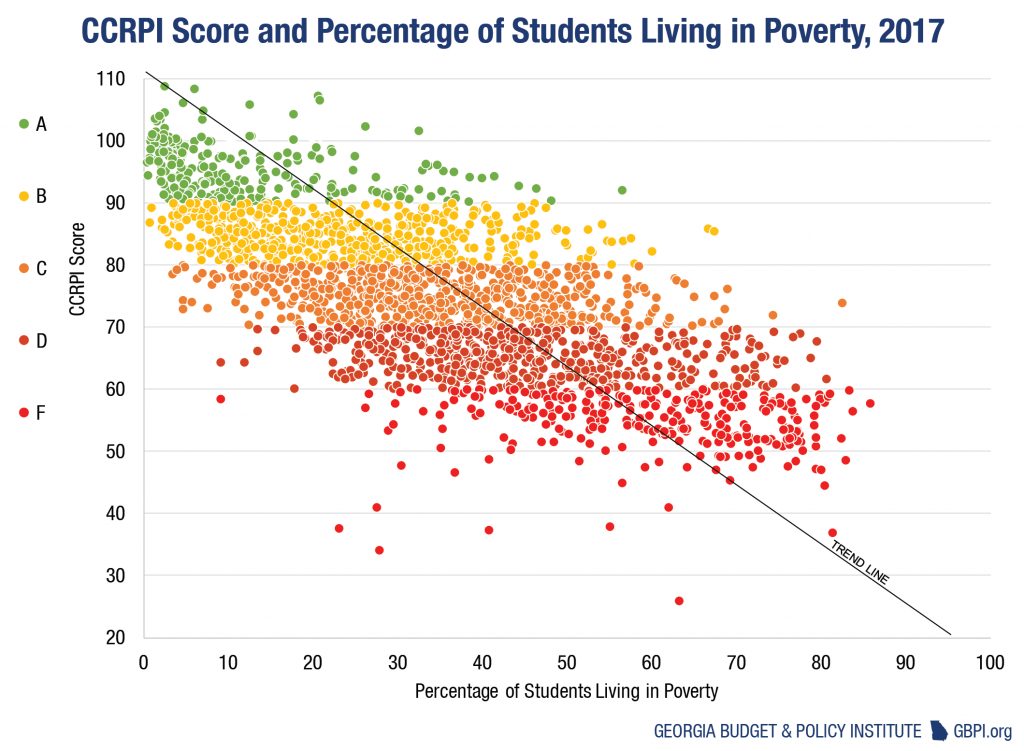This fall, the Georgia Department of Education is set to release its new annual scores for individual schools and districts, known as the College and Career Readiness Performance Index (CCRPI). Well-designed accountability systems can provide parents and policymakers with useful information, but Georgia’s approach relies too much on standardized testing and includes other shortcomings that warrant skepticism.
The index ranks each school’s and district’s ability on a 100-point scale to prepare students for life after graduation. Federal law requires every state to use an accountability system to flag schools that need to improve. The CCRPI was implemented as a key accountability measure in 2012. Low graduation rates, poor performance by students in a particular group, or low test scores overall are deficiencies the index can show needs improvement. Though federal law requires many problematic aspects of the index, state decision-makers are free to correct several shortcomings.
States can control many measures used to generate individual school scores. Georgia calculates CCRPI by combining multiple indicators of school quality, which vary by grades. Georgia’s high schools, for example, are graded by attendance rate, the percentage of students that complete a world language pathway and 17 other measures.
The large number of seemingly different individual measures masks the crucial fact that the overwhelming majority of a school’s score comes solely from the state-mandated Georgia Milestones assessment. The state mandated test is 82.5 percent of the score for elementary and middle schools and 70 percent for high schools.
Standardized tests like the Georgia Milestones are error-prone, as they often fluctuate based on things other than what the state intends to measure. Low scores might be the result of a poor education, but lack of sleep, an empty stomach, or a cold classroom might also be the culprit. Milestones reports sent to students include a “Standard Error of Measurement” section that gives the range of scores the student is likely to achieve if they were to take the test again to allow for these variables.
Standardized tests are limited by more than their error-prone nature. No test can measure the richness of a school’s curriculum, or whether a school provides a dynamic media center. Milestones tests maintain an outsized influence on the way the state rates school performance; the result is an incomplete picture of their work. State School Superintendent Richard Woods is on record agreeing with public sentiment the index relies too much on test scores.
The 100-point scale Georgia imposes on schools is another big drawback. The Governor’s Office of Student Achievement assigns the familiar A-to-F letter grade scale to the score. The agency’s website says the A-to-F scale is needed “so that parents and community members have clear and concise information on how their local schools are performing.”
But the rub is that assigning schools a traditional A-to-F grade — where A is 90 to 100, B is 80 to 89.9, etc. — might hide more than it reveals about the true quality of work at a school. Poverty creates a huge hurdle for students. So, it’s worth finding out if a school’s grade is due to the work of teachers, counselors and administrators or is an unintended measure of family income in the community. The chart below shows the relationship between a school’s CCRPI score and the percentage of students at each school who are living in poverty. You’ll see that lower levels of poverty translate into higher index scores and vice versa.
 Of the 486 schools in Georgia with more than half of students living in poverty, only Atlanta’s Early College High School at Carver received an A based on the 2017 CCRPI. By comparison, 216 of those schools were slapped with an F. Meanwhile, the schools that scored an A had a median poverty rate of just 8.4 percent, compared to the statewide average of 35.5 percent
Of the 486 schools in Georgia with more than half of students living in poverty, only Atlanta’s Early College High School at Carver received an A based on the 2017 CCRPI. By comparison, 216 of those schools were slapped with an F. Meanwhile, the schools that scored an A had a median poverty rate of just 8.4 percent, compared to the statewide average of 35.5 percent
Accountability systems provide state policymakers a way to identify Georgia’s communities most in need of support. Georgia’s College and Career Readiness Performance Index offers the potential to challenge all schools to serve their entire student populations well. But realizing that potential requires policymakers to rethink Georgia’s approach. The flawed structure of the state’s baseline education yardstick may simply reward or punish schools for their family’s income level, instead of the work they put in. As long as those underlying shortcomings remain, parents and lawmakers should take any broad labels that tag their schools as failing or succeeding with a grain of salt.



